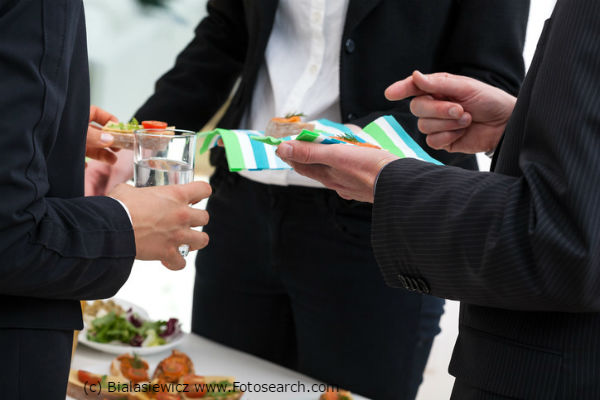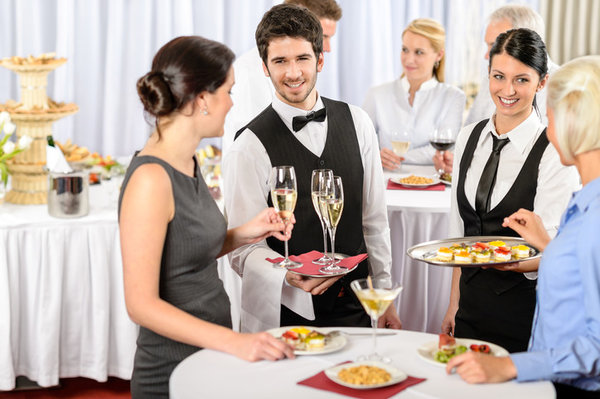
Building your people network takes time and many skills—asking questions, listening carefully, reading body language and more. It also takes practice. But one often overlooked skill set can derail all your best intentions and hard work: etiquette.
You remember your mom or grandmother telling you to sit up straight, face the table, don’t put your elbows on the table, no boarding house reach, pass the peas, right?
This blog walks you through the major etiquette points to help you build your people network. The previous post covered basics such as where to put your name tag and shake hands. This one deals with the dreaded round table for 8 and cocktail events.
Before we go there, let’s start with a basic rule–dress appropriately for the event you are attending. You can email or call the association manager if you don’t know what the dress code is. Usually you can assume people will be in business casual, at the least. That means no jeans, no T-shirts, no flip-flops.
If in doubt, dress up. It’s better to dress up then learn others are more casual than it is to go casual and find everyone in suits.
Ladies, always have a sweater or a jacket. Networking locations tend to be cold. And it’s hard to mingle and smile when you’re freezing.
For more tips on how to dress to impress, check out these sites.
Dressing for Networking
Ideas for Women
Tips for Men and Women
Let’s start with the dreaded table of eight. I’ve been networking for years, and I still have to stop and think any time I sit down at one of these tables.
My first thought is usually which parts of the place settings are mine and what belongs to my neighbor. The most fantastic tip I ever got on this came from a coaching client. Thanks to him I’ve never forgotten.
Here’s the big tip. Hold your hands in front of you and with each hand have your thumb and forefinger touch tips. On your left-hand, your fingers will resemble a lowercase B and the fingers on your right hand will resemble a lowercase D.
The B represents your bread, and the D represents your drink. Therefore, your bread plate is on the left side, and your drink is on your right side.
When you look at the silverware, start on the outside with your first course, then move closer to the plate. If your first course is the salad, the salad fork will be on the outside of the left silverware setting. Use your salad fork for your salad and leave this fork on your plate when you are done.
Your servers will be able to tell when you’re done with a course by looking at how you have positioned silverware on your plate. Put your fork and your knife next to each other pointing towards the middle of the plate. That’s the sign for them to clear your salad plate or your main course plate.
If you don’t plan on having coffee, it is okay to turn your coffee cup upside down and move the cup and saucer closer to the center of the table to give you a little room. This lets the servers know that you don’t want any coffee.
The bread is often put in the center of the table, frequently out of arms’ reach for most people sitting around the table. If that’s the case, stand up and move the bread bowl to where you and others can reach it. If someone asks for bread, pick up the bowl and pass it to your right.
The same goes with the salt and pepper. Get them within reach and pass them to your right.
Be sure to chat with your neighbors on both sides of you and attempt to make introductions with people around the table. For those on the opposite side from you, your introduction may be a wave and a smile and saying your name because they may not be able to read your name tag.
Wait until everyone at your table is served before you start eating. If this is a group that offers a blessing before the meal, wait until the blessing is offered before you eat.
Then eat your salad and your main course when it arrives. Go for dessert if you want. The dessert fork is usually horizontal at the top of your dinner plate.
It’s also common practice at a table of eight for people to pass their business cards around before the meal is over. Take seven of your cards and pass them to your right. Be sure you get a card from each other person at the table before you leave.
Usually the president of the association or an emcee will greet the crowd as meal service starts. It is fine to keep eating while the president or emcee is talking.
At some point while you’re eating, the emcee will introduce the speaker. If you have your back to the speaker, it’s totally appropriate to turn your chair around so you can give full attention to the speaker. You only do this if you are done eating.
If you find the speaker boring, pretend to be listening. It is rude to pull out your phone and start texting or sending emails while the speaker is speaking.
If the speaker is ultra boring and you don’t think you can last another minute, turn to the person on either side of you, whisper that it’s been nice to meet them and that you have to leave for an appointment. Quietly leave the table and walk out of the room.
If you need to go to the restroom, quietly stand up and walk out of the room. Be careful that you don’t let the door slam behind you as you exit. When you return, open the door quietly so everybody in the room doesn’t turn around to watch you re-enter.
If you are attending the event with coworkers, make sure each of you sits at a different table. Your goal in coming to the event is to meet people. If you sit with your coworkers at the same table, you’ll most likely speak only with your friends and ignore the others at the table. Leverage attendance at this event by having each of you sit at different tables so you can meet more people. You can always compare notes later.
Generally, you can sit at any table unless it has a reserved sign in the middle of the table. Those tables are frequently in the front of the room and are where guests, VIPs, and the speakers sit.
If you know you are going to have to leave during the middle of the speech, sit at a table near the back of the room. This minimizes the disruption of you leaving.
Check out this link for more:

If you are at a cocktail hour event, heed these guidelines.
If you are given drink or meal tickets at check-in, put them in the back of your name tag. Name tags are usually in a plastic holder of some sort and provide a great place for you to keep tickets at the ready.
Don’t live at the bar. You are not there to get drunk. Have a beer or glass of wine to help calm your nerves then switch to water.
Don’t pig out over the hors d’oeuvres. You are not there to eat dinner. You take a little food so you have something in your stomach to hold you over until dinner and to absorb any alcohol you ingest.
Find a place to sit your glass down so you can eat whatever food you’ve taken. You need both hands to eat and you need one hand free to shake other people’s hands, so make sure that you have a set up that allows you to do that easily.
Once you’ve had something to eat, it’s fine to have a glass in your hand as you mingle with other attendees. Hold your glass in your left hand so that your right hand is free to shake hands and pass out cards. You don’t want to have an ice-cold beverage in your right hand before you shake hands with another person. Your hand will be wet and cold and uncomfortable to the person whose hand you are shaking.
When the speaker is done, say goodbye to the people around you. This can be as simple as, “It was nice to meet you. I hope to run into you again.”
If you and an individual talked about how you need to follow up with each other, say something like, “I’ll email you later this week to see if we can set up time to continue our conversation.” Make sure to follow through.
If you are a first-time guest, be sure to let someone of stature let you know you enjoyed yourself. Find an association officer to say thank you and that you enjoyed the event or learned a lot from the speaker. This will help that person remember you the next time you visit.
If the officers are surrounded by others, at least tell the person at the check-in table that you enjoyed the event and expect to visit again.
Return your name tag. Those plastic name tag holders are expensive. Always return them to the check-in desk or look for a box near the exit that’s earmarked for name tag returns.
As you leave the event, look for a chance to walk out with other attendees. This is another opportunity for you to build your people network as everyone is returning to their cars.
© Pam Scott, MentorLoft.com 2017